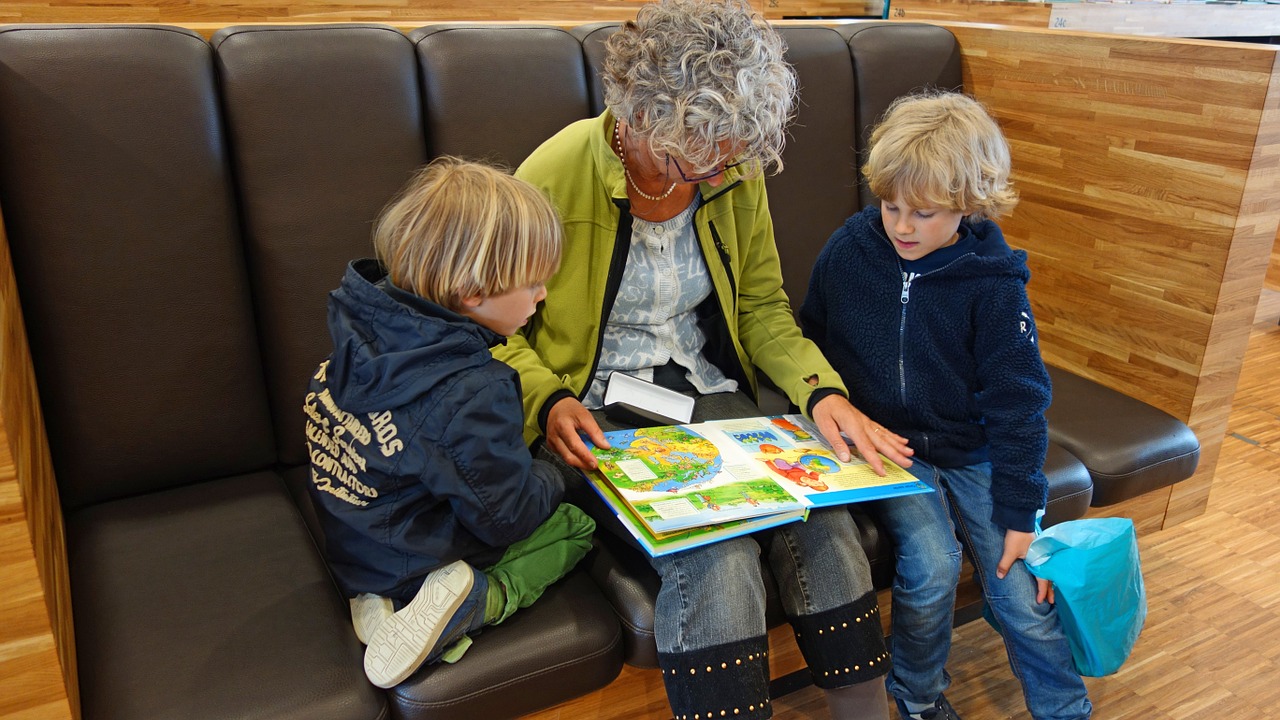Most parents know that reading books with their kids is important. But many parents don’t know why exactly. And it’s not as if parents get issued with an instruction book about how to read books with their kids for the best language, literacy, social and academic results.
Consider this article a mini-instruction book – a cheat sheet – based on some of the latest evidence about how to get the most out of reading books with your pre-schooler.
1. Why read books with your pre-schooler?
The peer-reviewed research evidence is very clear on this:
a. Read books with your kids:
Reading books with your kids:
- has a positive effect on later reading and maths skills;
- increases sustained attention; and
- reduces negative behaviours (Baker et al., 2013).
b. Read books frequently with your kids
Reading books more often with your pre-schooler increases:
- interaction, language, and pre-literacy skills (Hill & Diamond, 2013);
- reading, cognitive (i.e. intellectual), and numeracy skills until at least 10-11 years of age (Kalb & van Ours, 2014);
- letter knowledge and phonological awareness (Manolitsis et al., 2013);
- word recognition skills (Silinskas et al., 2012);
- receptive and expressive vocabulary (Senechal; & Lefevre, 2014);
- later literacy outcomes (Cunningham et al., 1997); and
- self-regulation (Walker, 2014).
2. How to read books with your pre-schooler
a. Read books “with” – not “to” your pre-schoolers
Peer-reviewed evidence shows that pre-schoolers have better outcomes when they participate actively in reading (Britto et al., 2006). On the other hand, reading books in a non-interactive way does not work as well, especially for children at risk for language delays or reading problems (e.g. Dickinson & Tabors, 2001). Children do not do as well when they just sit on your lap or lie in bed half-asleep being read to or at.
Academics love to call interactive reading ‘dialogic’, which is a word that comes to us from Greek, via Old French and Middle English. In simple terms, it means we want reading to be a two-way conversation with your kids about the book, with each of you taking turns and responding to the other’s gestures, words and observations.
b. Practical tips for how to turn passive book-reading into an active conversation
- Books are not just for bedtime, when everyone’s tired and you want your kids to settle for sleep. I love bedtime reading. But you should mix it up and read at other times too. For example, when my boys were younger, we loved to read books straight after breakfast on Sundays and then act them out in the back yard (especially books about emergencies and battles).
- Let your child choose the book. Your child will learn more from a book if it matches his/her interests. A quick trip to the library will give you a good idea of the types of books your child likes.
- Don’t forget about non-fiction books. Story books are great. But if your son or daughter loves dinosaurs, trucks, or trains, explore their interest! I find many young boys with language delays love books about cars and dinosaurs, for example. I had one client who loved to read about going to the dentist!
- If your child wants to read the same book over and over, just do it!
- Focus on what your child is looking at in the book and go at their pace.
- You don’t need to read the book in order, or cover-to-cover. If your child loves a particular picture, spend more time there talking about it.
- Don’t do all the talking! Hold your peace and wait for your child to say something. Say something about the book, and then be quiet for 5 seconds and wait expectantly. Give your child time to take a turn or make a comment, and then respond enthusiastically.
- Don’t ask too many questions – especially ‘yes/no’ closed questions or ‘what’s that?’ questions. Kids (like all of us) hate being interrogated about stuff when they know you know the answer. Make comments about the book, and then simply wait expectantly. Instead of saying ‘What colour is that?’, or ‘Is he happy?’ or ‘What’s that?’, you could say ‘I like his green skin, it looks so slimy!’, or ‘I can see the frog swimming under the lily pad’, or ‘He looks so sad! I can see tears on his cheeks, poor frog!’ and then wait for your child to have a turn and respond.
- At the end of each page, pause and wait for your child to comment (even if it’s simply: ‘Hurry up Dad, turn the page!’).
- If your child wants to expand on what’s happening in the story, show enthusiasm and join in!
- Don’t be afraid of using and explaining advanced vocabulary – especially interesting words, e.g. ‘deciduous’, ‘drenched’ and ‘destructive’, especially after multiple readings of the same book. With new words, say them slowly, make them louder and longer than other words, say them repeatedly in sentences, and tie the new word to other words your child already knows, e.g. ‘The bear hibernated – he went to sleep for a long time. He hibernated for weeks and weeks. He hibernated in his cave. He was very sleepy. He couldn’t wake up because he was hibernating!’. Here’s an example of how one of our amazingly creative clients learned about the word ‘catapult’ from Pamela Allen’s ‘The Pear in the Pear Tree’. Love it!

- Act out the books. Use stuffed toys or puppets or Lego or action figures or dolls. I love doing this with books like Who Sank the Boat and There was an Old Lady who swallowed a Fly.
- Read books that provoke or even irk your child into a response. My current favourite is ‘This is a ball‘, which never fails to get a strong response from even reluctant talkers!
- When reading a book for the second (or 100th) time, help your child think more deeply about the story:
- talk about the story elements: the main character, the setting of the story, the goal of the main character (or the problem he/she is tackling), what happens, and the ending and how it makes you feel.
- think ‘out loud’ for your child’s benefit about what’s happening in the story and why, e.g: ‘I’m thinking that the frog is sad’, or ‘I’m wondering about when the bear will wake up’, or ‘I’m trying to figure out what will happen when the princess kisses the frog’.
- ask open, more complicated questions, like ‘How does she feel?’, ‘Have you ever felt that way?’, ‘What would you do?’, ‘What do you think will happen next?’ and ‘Why do you think she’s happy?’. If, after waiting, your child doesn’t respond, answer your questions with what you think, then wait. Being a bit silly can sometimes provoke a response, e.g. ‘I think the princess will turn into a frog too!’. Connecting the action in the book to your child’s life can boost vocabulary development, comprehension and recall of facts (e.g. Aram et al., 2013).
- With repeated readings of favourite books (or with alphabet books), bring your child’s attention to the printed words, letters and sounds to build their print awareness and phonological awareness:
- help your child notice the letters and words to build their print awareness. Show them the cover page, the way the words are written across the pages from left to right, and how words are made of letters. Point out printed words wherever you see them during the day, e.g. on signs, cereal packets, and other books; and
- highlight letters and explain the sounds they make to build your child’s phonological awareness skills, which are related to later reading outcomes.
Related articles:
- Teaching the alphabet to your child? Here’s what you need to know
- Preparing your pre-schooler to learn to read. Skills to focus on first
- Before Big School, does your preschooler need help with pre-reading skills? Introducing PreLit sessions
- Kick-start your child’s reading with speech sound knowledge (phonological awareness)
- Is your child struggling to read? Here’s what works
- How to help your child to learn new words – the nuts and bolts of how I actually do it in therapy
- Do we spend too much time on rhyming books? What else should we do to prepare pre-schoolers to read?
- FAQ: In what order and at what age should my child have learned his/her speech sound consonants?
Principal source: Greenburg, J. (2015). I’m Ready!: Coaching Parents to prepare their pre-schooler for literacy success. An eSeminar, which I attended on 10 May 2017. Many of the strategies highlighted above are based on this seminar, which, in turn, were derived from “I’m Ready! How to Prepare your Child for Reading Success” by Janice Greenburg and Elaine Weitzman of the Hanen Centre in Canada.
Image: http://tinyurl.com/mvjc57v

Hi there, I’m David Kinnane.
Principal Speech Pathologist, Banter Speech & Language
Our talented team of certified practising speech pathologists provide unhurried, personalised and evidence-based speech pathology care to children and adults in the Inner West of Sydney and beyond, both in our clinic and via telehealth.


Leave a Reply